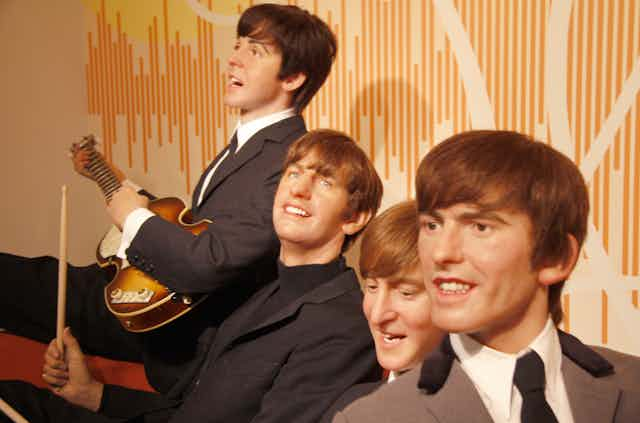In 2011, pop music scholar Simon Reynolds was already observing pop culture’s fascination with its own past, noting that “we live in a pop age gone loco for retro and crazy for commemoration.”
For Reynolds, this obsession with the past has the potential to bring about the end of pop music culture: “Could it be,” he asks, “that the greatest danger to the future of our music culture is … its past?”
The situation has not improved in the years since Reynolds voiced his concerns. Our fixation on the popular music of previous decades threatens our future by stifling originality.
Thanks to recording technology, and now to more recent developments in artificial intelligence and machine learning, we find ourselves more and more in a spectral present, thoroughly haunted by the ghosts of pop music’s past.
Ghostly presence
This type of hauntedness can provoke anxiety. Hauntology, a theoretical concept originating in the work of French philosopher Jacques Derrida, was later applied to musicology by critic Mark Fisher. Hauntology is concerned with memory, nostalgia and the nature of being. The present is never simply “present,” and the remnants of our cultural past always linger or return.
A ghost, in literature, folklore and popular culture, is a presence from the past of something or someone that no longer remains. Is a ghost, then, from the past or of the present? As hauntology would insist, a ghost is paradoxically both at the same time.
In November 2023, pop phenomenon the Beatles released a “new” song titled “Now and Then.” It received a rapturous reception from fans and critics alike, and was soon topping the charts in the United States and the United Kingdom, becoming the fastest-selling single of 2023.
The song features a lead vocal track by the late John Lennon, salvaged from a demo recording he made at home in the late 1970s, just a few years before his murder in 1980. It also includes archival guitar tracks from the late George Harrison.
The two surviving Beatles, Paul McCartney and Ringo Starr, contributed new bass, drum, vocal and guitar parts (McCartney even played a slide guitar solo mimicking Harrison’s sound and style), and producer Giles Martin (son of legendary Beatles’ producer George Martin) provided a string arrangement and a tapestry of background vocals lifted from other iconic Beatles songs.
“Now and Then” was also celebrated for the technological sophistication of its production, and specifically for its use of artificial intelligence. Using software that could tell the difference between a human voice and other sounds on a recording, Lennon’s voice was isolated and reanimated, allowing McCartney and Starr to perform alongside their long-deceased bandmate.
Final masterpiece
“Now and Then,” in addition to being a “new” Beatles tune, is likely also the group’s last: there are no more old recordings to resurrect, and McCartney and Starr are both octogenarians.
Indeed, according to music critics like The Guardian’s Alexis Petridis, “Now and Then” is an emotionally satisfying “act of closure.” It stands on its own as a genuine addition to the Beatles’ catalogue, wrapping up the band’s career and “never stoops to deploying obviously Beatles-y signifiers.”
Music journalist Jem Aswad, writing in Variety, characterizes “Now and Then” as a “bittersweet finale.” While Aswad is mildly critical of the song as an “incomplete sketch,” he insists at the same time that any further criticism is just unwarranted sour grapes, concluding that it is “an unexpected pleasure that marks the completion of the group’s last bit of unfinished business.”
Haunted, ghostly
Some critics, however, echoing Reynolds’s concerns, found “Now and Then” decidedly less praiseworthy. Josiah Gogarty’s brutal review, published in UnHerd, argues that the song serves as “a sign of our cultural doom loop,” and likened it to a “séance, calling forth the warbling and the jangling of the dead.”
The recording includes McCartney’s count-in at the beginning and some studio chatter from Starr at the end, as if to reassure listeners that the song is a product of living musicians.
At the same time, the song is eerily placeless or ahistorical, caught somewhere between past and present: a haunted, ghostly thing, evidence of a pop culture that has long ceased to evolve.
Limiting the future
The problem is the way songs like “Now and Then” are imbued with nostalgia: they threaten the future and limit the possibility of the emergence of new ideas.
Fisher feared the effect of this sort of nostalgia giving rise to “a cancelled future.” We can readily imagine such a future, because we already inhabit it: a future of never-ending tours by impossibly decrepit rock bands, countless re-boots of old movies and television shows, the fetishization of all that is vintage.
Even the most stunningly progressive technological developments — such as the AI that made “Now and Then” possible — turns out to serve a regressive purpose, namely to resurrect the Beatles.
A generous take on “Now and Then” would be to view its arrangement and production as capturing and amplifying the meaning of the song lyrics: “Now and then I miss you … I want you to return to me.” These lyrics suggest the presence and absence theorized by hauntology, which is cleverly reflected in the song’s haunted soundscape.
Less generously, “Now and Then,” rather than an act of closure, simply continues an ongoing trend of looking backwards in pop music. It indicates that our insecurities about our future ensure we will remain forever entangled with its ghosts.

